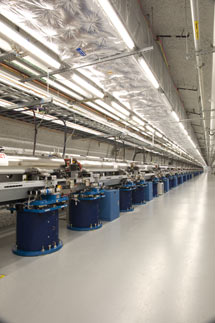
Handy Links
SLAC News Center
SLAC Today
- Subscribe
- Archives: Feb 2006-May 20, 2011
- Archives: May 23, 2011 and later
- Submit Feedback or Story Ideas
- About SLAC Today
SLAC News
Lab News
- Interactions
- Lightsources.org
- ILC NewsLine
- Int'l Science Grid This Week
- Fermilab Today
- Berkeley Lab News
- @brookhaven TODAY
- DOE Pulse
- CERN Courier
- DESY inForm
- US / LHC
SLAC Links
- Emergency
- Safety
- Policy Repository
- Site Entry Form

- Site Maps
- M & O Review
- Computing Status & Calendar
- SLAC Colloquium
- SLACspeak
- SLACspace
- SLAC Logo
- Café Menu
- Flea Market
- Web E-mail
- Marguerite Shuttle
- Discount Commuter Passes
-
Award Reporting Form
- SPIRES
- SciDoc
- Activity Groups
- Library
Stanford
Around the Bay
LCLS Beam is Back—And Twice as Fast!
The Linac Coherent Light Source came back online early last week, after a holiday hiatus. On Thursday the LCLS team ramped the X-ray laser up to its full design rate of 120 pulses per second—twice its previous operating rate—for the first time. And like the first attempts to create X-ray laser light at LCLS in 2009, it worked elegantly.
"Due to the careful way that things were shut down for the Christmas break, we were able to bring the accelerator back up in the same state as before the break, with very few glitches," said LCLS accelerator physicist Jim Turner. "Shortly after that, we raised the repetition rate of the accelerator from 60 Hertz to 120 Hertz. That was also well planned, and worked very well."
The higher repetition rate—the rate at which electron pulses travel through the linear accelerator, and the rate at which those electrons produce X-ray pulses—means scientists using the LCLS can collect data twice as fast as before.
"The whole point of LCLS is that it's a pulsed source, so the information comes in with each pulse," said John Arthur, head of LCLS X-ray operations. "Give twice as many pulses and you get data faster. One year ago we were running at 30 Hertz; last fall we were running at 60 Hertz. We've slowly increased the rate, which involves running the accelerator and all of the components faster."
"It's been a huge effort," between teams across the lab, explained LCLS Accelerator Division head David Schultz. The klystrons and modulators that power the linac had to be tuned to run at a higher rate. Cooling systems needed retuning to handle the additional power load. Careful checks were made for any potential radiation safety issues. Accelerator control systems that monitor the beam and keep things stable had to be adjusted for the higher repetition rate, among many other preparations.
"Right now, the beam looks very good," Turner said. "Both the peak current and what I call the distribution profile are very good." The distribution profile describes a cross section of the beam—a good beam gives a nice, round dot—and how steady the beam is, Turner explained. "All those things are indicative of how well the machine is tuned up and running. We thank everyone who contributed to this great effort."
For the next few days, the beam will be focused on the Far Experimental Hall, where instrument scientists are commissioning the LCLS's fourth experimental instrument, the Coherent X-ray Imaging instrument. Then, beginning this Thursday, January 13, scientific users will arrive to take advantage of LCLS's new capabilities.
—Shawne Workman
SLAC Today, January 10, 2011
